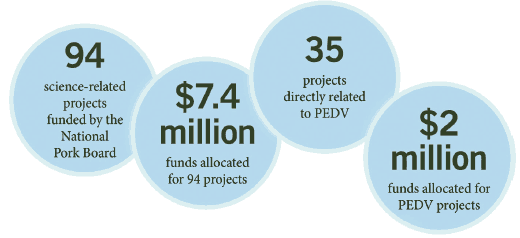News from the National Pork Board (mar 2015)
Chris Hodges, a pork industry leader with substantial senior management experience in agriculture, has joined the National Pork Board as its new chief executive officer. Previously based in Kansas City, Hodges was most recently senior vice president-business development of Smithfield Farmland.
“When I first joined what was then Farmland Industries as a grain division manager, I joined a farmer cooperative,” said Hodges. “Over the years, I have grown to understand the needs and challenges facing pork producers from product marketing to disease management to sustainability.”
Hodges brings to the Pork Checkoff decades of in-depth knowledge and innovation in marketing pork to key US food retailers and into international markets. Much of his fresh pork marketing experience includes direct producer outreach and involvement related to adopting on-farm practices specifically designed to improve overall meat quality.
“As we move forward with the implementation of our new 2020 strategic plan, we feel confident that Chris is the right person to lead the organization,” said Dale Norton, president of the National Pork Board and a producer from Bronson, Michigan. “He brings not only years of professional work experience, but first-hand knowledge and insight into our changing industry. We welcome him on board.”
PQA Plus versus the common audit
By now, you are somewhat familiar with the recently launched pork industry’s Common Swine Industry Audit, but you may still have questions about how it differs from the Pork Quality Assurance Plus program, which is managed by the National Pork Board.
“The industry has come together on this audit platform with the goal of better serving the needs of farmers, packers, processors, retail and foodservice providers, and consumers,” said Sherrie Webb, director of animal welfare for the Pork Checkoff. “The new audit is not a Pork Checkoff program, but rather an initiative led by producers and packers working together to enhance animal care and pork safety.”
While Pork Quality Assurance Plus (PQA Plus) and the TQA programs serve as a foundation for the Common Swine Industry Audit, the purposes and outcomes are different. Here’s a look.
PQA site assessment:
• Educational and benchmarking tool.
• Measurement and feedback from a trained PQA Plus advisor on the effectiveness of training and management to ensure pig well-being.
Common Swine Industry Audit:
• Objective snapshot by an independent party, with no education component.
• Verification that the pork industry’s approved animal well-being standards are being followed.
For more information on PQA Plus or the Common Swine Industry Audit, go to www.pork.org/commonaudit or contact Sherrie Webb at SWebb@pork.org or 515-223-3533.
Science and Technology Department highlights 2014 figures
Although 2014 was dominated by the challenge of battling porcine epidemic diarrhea virus (PEDV), the Pork Checkoff’s science and technology team continued to work on many other critical issues as well under the guidance of its producer-led committees. The Science and Technology Department’s overall strategy to advance the industry’s knowledge and sustainability by creating practical on-farm solutions in all of its key areas remains firm – and will be critical to the success of the National Pork Board’s new 5-year strategic plan. Some key figures from 2014 are highlighted below. If you want to find out more, go to www.pork.org.

Find answers to low farrowing rates and more
The National Swine Reproduction Guide is a Web-based trouble-shooting guide that is available at usporkcenter.org/store from the US Pork Center of Excellence. Accessed through personal computers, smartphones, and tablets, the guide offers extensive information and support to help producers solve swine reproductive problems. The cost is $75 annually for the licensing fee, with a 1-week free trial available. For more information, contact Chelsey Branderhorst at CBranderhorst@usporkcenter.org or call 515-223-2641.
New Swine Health Information Center forming board of directors
With its goal of improving the US pork industry’s preparedness for disease challenges, the new national Swine Health Information Center (SHIC) has announced several of its key board members as it gets closer to its proposed operational start date of April 1.
According to Paul Sundberg, vice president of science and technology at the National Pork Board (NPB), the nonprofit organization’s board of directors who represent the National Pork Board, the National Pork Producers Council (NPPC), the American Association of Swine Veterinarians (AASV), and at-large US pork producers will welcome the following people to help them fulfill the mission of the new center.
From AASV, Dr Matt Anderson, Algona, Iowa, and Dr Daryl Olsen, Audubon, Iowa; from NPPC, Dr Howard Hill, Cambridge, Iowa, and Bill Luckey, Columbus, Nebraska; and from NPB, Dr Brett Kaysen, Nunn, Colorado, and Mark Greenwood, Carlyle, Illinois. At-large producers being filled at time of printing.
“We’re very pleased that these individuals will help direct the center’s strategies that will help us to implement the primary goals of the new organization,” Sundberg said. “Their input and oversight will be critical to our success.”
The four main objectives of the autonomous SHIC include forming a network to identify, prioritize, and update information about diseases around the world that pose various levels of risk to the US swine herd; enhancing the diagnostic capabilities needed to detect and respond to those diseases; providing the infrastructure for industry-driven and controlled data needed for analysis and communication of endemic and emerging swine health issues; and enhancing producer and veterinarian awareness of the biosecurity and biocontainment needed to address emerging disease risk.
“It’s our intention to establish a center that can improve our preparedness for swine diseases with the combined resources or collaboration of swine veterinarians, producers, researchers, diagnosticians, and state and federal animal-health officials,” Sundberg said. “We have learned a lot over the past year and a half from our experience with porcine epidemic diarrhea virus and we want to create a unique, collaborative system that will help us achieve our overall goal of being better prepared for the next emerging swine disease.”
